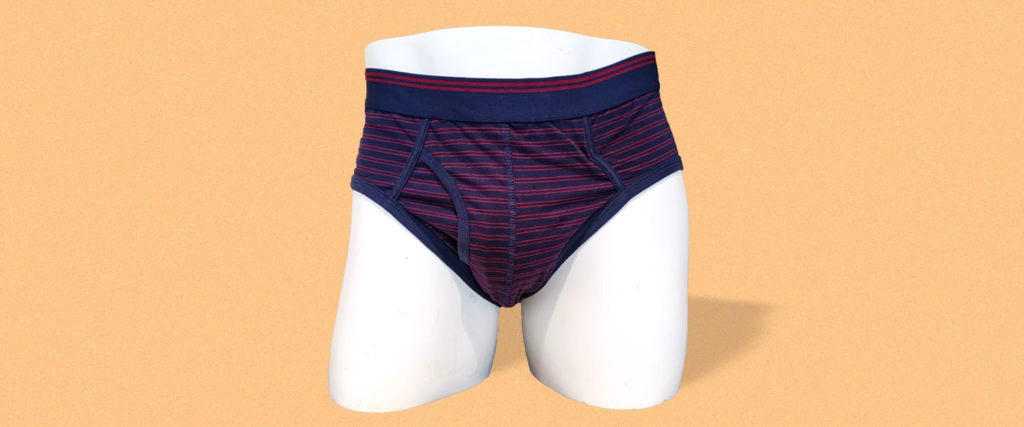It’s important to question things. That’s how humanity advances — asking questions of itself and changing accordingly. No progress would have ever been made if we hadn’t looked at how we lived and thought, “But does it have to be like this?”
For instance, underwear. Is it what it should be? Does it have to be like this? Why do we even wear it?
1) Because We Kind of Always Have
Underwear has been around for a long, long time. Vastly before any of the rest of what we think of as clothing conventions had been developed, if you were only going to cover a small amount of your body, it would be your junk. Different civilizations have had different attitudes toward concealment and modesty, but none of them have ever gone for a “T-shirt up top, dick waggling about below, dirty ass to the back” look.
Loincloths in their most simple form — some fabric around the waist that covers one’s genitals — have been around since at least 5,000 BC. Ötzi the frozen caveman, who died in about 3,100 BC, was wearing a loincloth. Variations on the same kind of thing seem to have developed independently across the world. The ancient Romans and Greeks were perfectly comfortable with nudity if doing something that required it, like, um, wrestling, but were still generally clad most of the time — the wealthy fully-clothed in robes and togas, the poor in tattered loincloths.
It means that underwear is something of an opt-out system — wearing it is very much the default, and the world is built with underpants-wearers in mind. Most clothes are made with the assumption they’ll be worn over underwear, and whole systems (like how dressing rooms at stores work) would be different if a packaged package wasn’t the norm.
2) To Conceal and Protect Our Thunder
You’re not meant to wander around with your junk out. It’s not really allowed. Again, clothes are designed with the assumption that there will be underpants — the trend for shorter shorts, for instance, would probably not be a thing if they perpetually had a big set of nuts hanging out of them.
In modern, betrousered times, opting to go without underwear puts you at risk of severe chafing from the seams, zips and so on that make up the crotch area of a standard pair of pants. You’re also that bit less likely to get any important meat chewed up in a zipper with a protective layer of undie.
There’s a mental element to it as well — it’s an extra layer of material between the world and some of our most sensitive body parts, which can make people feel just that little bit more secure both physically and psychologically.
The actual health benefits or drawbacks of underwear really depend on exactly what you’ve gone for. Underwear that’s too tight, or made of shitty fabric that doesn’t let your genitals breathe, will do you no good at all. While quality underwear will wick sweat away and reduce your chances of rashes, inflammation and stinking like a full-body groin, bad underwear will lean into that shit, riding up into all kinds of crevices, chafing you like crazy and causing butt zits, crotch-rot and swamp-ass.
3) For Hygiene and Your Wallet
If you have a particularly sweaty ass or crotch, going without underwear might mean getting rid of half the pants you own in order to avoid groin sweat patches. Light grey trousers around a pair of dripping nuts? Absolutely not.
You can wear a pair of jeans for weeks. But if your smelly asshole has been rubbing up against it all day, you might feel differently. Sometimes, a bit of wee-wee dribbles out into your underpants, which is fine, as you’re only wearing them for a day. But think of how much rancid piss would accumulate in a pair of jeans over the course of three or four weeks without underwear to soak it up. Three drips of piss a day for a month and you’re walking around with the dried-up equivalent of one whole medium-sized piss on your trousers. Fling in everything else that can drip, seep or blast out of you (whatever kind of genitals you have, you’re never more than one bad hour away from a mess) and things are getting pretty grim.
People fart, on average, somewhere between five and 15 times a day. Calling it 10, a pair of jeans worn for a month without underwear has had 300 unfiltered farts fired through the ass of it. Choosing to envelop yourself in that is, surely, no way to live.
As George Carlin once said, on any given day you only really need to clean your armpits, asshole, crotch and teeth (and can save time by using the same brush for all four). Clothing that comes into contact with any of those places, we tend to change daily — a T-shirt on day two is noticeably honkier than day one, while a jacket worn over other layers never gets smelly. Having a small garment centered around two of the four areas means the pile of clothes discarded at the end of the day is way smaller than it could be, which means saving money both on laundry and on needing to own loads of pairs of pants.
4) To Save the World
If we accept that going without underwear means washing our pants after every wear, think of the environmental cost — they’re physically larger, which means fewer per load, which means more loads. That’s more electricity being used, more water being wasted and a vastly greater amount of wear and tear on both the clothes themselves and the washing machine. Clothing manufacturing is a massive source of global water waste, and there are mountains of broken-down washing machines — over 42 million tons of household goods are discarded every year.
Is free-ballin’ it really worth more than the planet, you monster?

